挥发性有机物(volatile organic compounds, VOCs)是生成臭氧(O3)和二次有机气溶胶(SOA)的重要前体物[1].近年来随着城市迅速发展, 我国城市O3浓度逐年上升, 已成为继PM2.5之后另一区域性重要污染物.O3和PM2.5污染具有典型的季节性, 夏季O3污染和秋冬季PM2.5污染协同控制将是未来一段时间内我国空气质量防治的重点.环境空气中VOCs化学组成复杂来源多样, 开展VOCs污染特征及来源研究对于制定精准高效的大气污染综合治理策略, 更好地实现PM2.5和O3污染协同控制具有重要指导意义.
目前国内关于VOCs污染特征的研究主要集中在珠三角[2~6]、长三角[7~12]、西南部[13~15]及京津冀区域[16~19]等经济发达和人口密集的城市.天津市位于京津冀区域中北部, 是京津冀城市群和环渤海经济圈中重要的工业和港口城市, 石油、化工和装备制造等工业发达, 拥有国家级石油化工基地, 同时机动车保有量高、港口吞吐量大, 是京津冀区域O3污染较重的城市之一[20].近年来天津市开展了部分VOCs污染特征研究[21~25], 但研究数据主要集中于2015年以前. 2013年国家开始实施《大气污染防治行动计划》, 2017年以来京津冀每年秋冬季实施大气污染综合治理攻坚行动方案, 我国污染源排放发生较大变化[26~28], 因此十分有必要基于近期监测数据, 开展天津市VOCs污染特征及来源研究, 以期为天津市O3和PM2.5污染防控提供科学依据.
1 材料与方法 1.1 观测场地采样点位于天津市生态环境监测中心4层楼顶(39°05′N, 117°09′E), 采样高度距地面约15 m, 为天津市生态环境监测中心超级观测站.采样点周边主要为文教住宅区, 无明显工业污染源排放, 北侧300 m左右为复康路交通主干道, 可能带来一定交通源影响.监测点位分布见图 1.
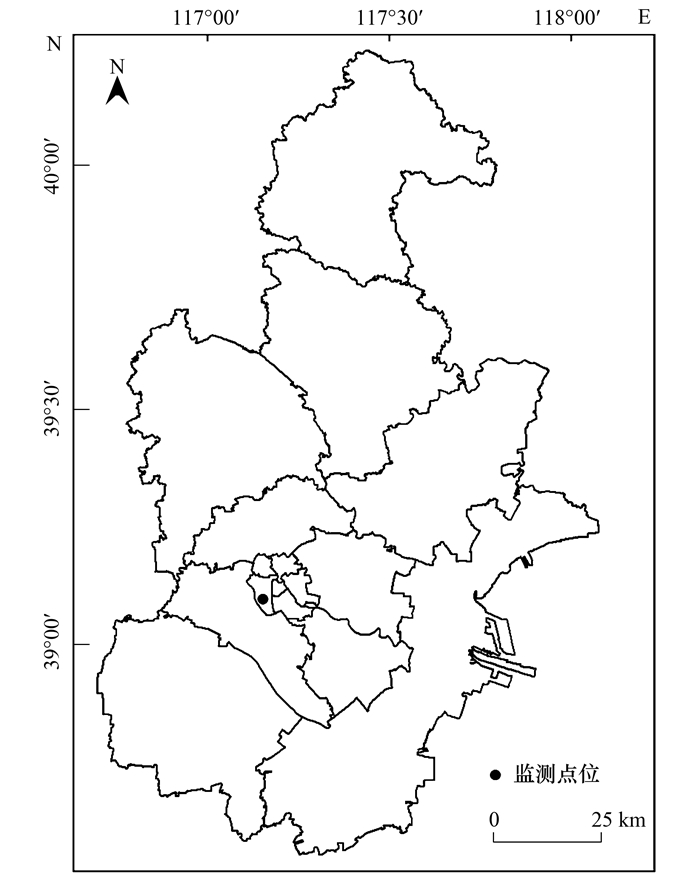
|
图 1 监测点位分布示意 Fig. 1 Location of the sampling station |
采用美国PerkinElmer Clarus公司在线气相色谱分析系统监测环境空气中VOCs, 该分析系统包括自动采样浓缩仪、热脱附仪、50 m×0.32 mm硫酸钠脱活氧化铝色谱柱、50 m×0.22 mm×1 μm甲基硅烷色谱柱以及双FID检测器, 分别分析C2~C6低沸点组分和C6~C12高沸点组分, 可监测56种光化学评估监测网(PAMS)挥发性有机化合物, 包括29种烷烃、10种烯烃、16种芳香烃以及乙炔, 时间分辨率为1 h.每日00:00~01:00采用摩尔分数为2×10-9的Linde Gas North America LLC标准气体自动开展单点质控检查, 当响应值与浓度偏差在30%以内时认为合格, 否则进行多点校准重新绘制标准曲线.定期开展设备维护, 至少每季度进行一次多点校准, 以保证监测数据的准确性和有效性.监测时间为2019年1月1日至12月31日, 除仪器故障或维护等造成的VOCs数据缺失外, 共获得6766组有效数据(有效数据率达到80.6%).
1.3 研究方法 1.3.1 臭氧生成潜势计算方法采用最大增量反应活性(maximum incremental reactivity, MIR)法估算VOCs的臭氧生成潜势(ozone formation potentials, OFP)[29, 30], 计算公式如式(1):

|
(1) |
式中, OFPi为VOCs物种i的O3生成潜势量, 单位为μg·m-3; ρ(VOCsi)为物种i的实测浓度, 单位为μg·m-3; MIRi代表在不同VOC/NOx比值下VOCs物种单位浓度增加最大可产生的O3浓度[30], 单位(以O3/VOCs计)为μg·μg-1, OFP越大表明VOCs的O3生成潜势越大.
1.3.2 SOA生成潜势计算方法采用气溶胶生成系数(FAC)估算VOCs的二次有机气溶胶生成潜势.计算公式如式(2):

|
(2) |
式中, SOAp为VOCs对SOA的生成潜势, 单位为μg·m-3; VOCst为环境中VOCs物种实测浓度, 单位为μg·m-3; FVOCr为该物种参与反应的质量分数, 单位为%; FAC为SOA生成系数, 单位为μg·μg-1, 以SOA/VOCs计.公式中FAC和FVOCr由烟雾箱实验获得[31, 32].
1.3.3 正交矩阵因子分解(PMF)模型本研究使用EPA PMF5.0开展VOCs来源解析, PMF基本原理是利用权重计算样本中各化学组分的误差, 通过最小二乘法确定主要污染源及其贡献率, 具体表达式如式(3)和式(4), 不确定度计算参考文献[33, 34]:

|
(3) |

|
(4) |
式中, xij为i×j矩阵, i为样品数, j为VOCs种类数目, 再将x分解为矩阵g和矩阵f, 其中g为i×k的源贡献矩阵, f为k×i的源成分谱矩阵, p为主要的污染源数目, uij为xij的标准偏差, e为残差矩阵. PMF模型在求解过程中的数学约束是使实际Q接近理论Q.
2 结果与讨论 2.1 VOCs浓度及组成特征 2.1.1 浓度分布特征2019年天津市环境空气中VOCs年均质量浓度为48.9 μg·m-3, 其中烷烃、烯烃、芳香烃和炔烃浓度分别为31.8、7.1、8.5和1.5 μg·m-3.烷烃在VOCs中所占质量分数最高(65.0%), 其次是芳香烃和烯烃(17.4%、14.6%), 炔烃占比相对较低(3.0%).
与国内其他城市相比(表 1), 天津市VOCs年均质量浓度略高于太原和唐山, 明显低于邯郸、阳泉和成都等城市.组成特征上, 天津市烷烃占比与近两年上海、长沙烷烃占比相当, 在各城市中处于较高水平; 烯烃占比也相对较高, 芳香烃占比明显低于其他城市.这可能与不同城市间能源结构、产业结构、地理条件以及采样时段存在差异有关.时间尺度上, 与2011年天津市VOCs浓度和组成特征相比, 2019年天津市VOCs浓度下降50.1%, 烷烃占比明显上升, 芳香烃占比显著下降, 烯烃占比略有下降.烷烃主要来自汽油等燃料的不完全燃烧以及天然气、液化石油气排放等, 烷烃占比上升主要受近年来天津市机动车保有量增加以及煤改燃治理工程影响; 芳香烃是有机溶剂的主要成分, 2015年以来天津市每年开展夏季臭氧污染防控专项行动, 通过推进重点行业低(无)VOCs含量原辅材料和产品替代、加强有机溶剂作业排放管控等方式强化溶剂使用源精细化治理, 使芳香烃占比明显下降; 烯烃是重要的有机化工原料, 占比较高与天津市石化工业产业发达有关.
|
|
表 1 天津市VOCs浓度组成与国内其他城市比较1) Table 1 Composition of ambient VOCs concentrations in some cities of China |
2.1.2 季节分布特征
以3、4和5月为春季, 6、7和8月为夏季, 9、10和11月为秋季, 1、2和12月为冬季, 分析2019年天津市VOCs浓度季节变化.天津市春季、夏季、秋季和冬季VOCs平均质量浓度分别为34.6、42.0、47.9和66.9 μg·m-3, 呈现出冬季高、春季低的特点.从VOCs组成季节分布看(图 2), 烷烃、烯烃、芳香烃和炔烃浓度均为冬季最高、春季最低, 但烷烃浓度秋季明显高于夏季, 芳香烃浓度夏季高于秋季, 烯烃和炔烃夏秋季浓度相当.从浓度占比上看, 烷烃在VOCs中占比62.8%~68.1%, 秋季最高, 夏季最低; 烯烃占比13.4%~15.4%, 冬季和夏季较高, 春季和秋季较低; 芳香烃占比15.9%~19.1%, 夏季占比最高, 秋季最低; 炔烃占比2.5%~3.7%, 冬季较高.

|
图 2 不同季节VOCs浓度及组成占比 Fig. 2 Concentrations and compositions of VOCs in different seasons |
冬季天津市采暖用燃煤、燃气量增加使VOCs排放量大幅增加, 但气温较低光化学反应减弱使VOCs消耗量减少, 且冬季容易受静稳天气影响, 与其他季节相比扩散条件相对不利, 导致VOCs在本地累积, 浓度相对较高.夏季气温较高利于VOCs组分挥发, 特别是植物等天然源排放以及溶剂使用源等人为源挥发排放使烯烃和芳香烃浓度明显增加, 但高温强辐射环境也有利于这两类活性较强VOCs发生大气光化学反应转化为臭氧, 因此夏季VOCs浓度低于秋冬季, 但烯烃和芳香烃占比较高.
2.1.3 典型示踪物特征比值VOCs典型示踪物比值分析法可初步指示VOCs污染来源或某些VOCs物种来源[40].如苯/甲苯比值(B/T)、异戊烷/正戊烷比值(I/N)可以识别机动车尾气或燃煤、溶剂挥发等贡献, 当B/T值接近0.5时主要贡献为机动车排放[41], B/T>1时主要受燃煤影响[42, 43], B/T < 0.4时主要为溶剂使用源贡献[44]; 当I/N值接近2.9时主要为机动车排放贡献, I/N在0.5~0.8之间时主要为燃煤影响[45]. 2019年, 天津市B/T值在夏季接近0.5, 呈现交通源和溶剂使用源共同影响特征, 春季略有上升; 秋冬季B/T值均大于1.0, 燃煤源影响突出.I/N比值春季为3.0, 与机动车排放源I/N值最为接近, 秋冬季比值在1.5左右, 显示出燃煤源与交通源共同影响(图 3).乙烷/乙炔比值(E/A)可表征VOCs气团的光化学龄, 乙炔为活性较大的组分, 而乙烷活性较低, 在光化学进程中乙炔不断被消耗, E/A比值上升(>0.47), 表明大气存在老化现象[46].天津市E/A比值在4.8~6.5之间, VOCs气团存在明显老化现象, 秋季最强, 夏季最弱, 可能与夏季光化学反应更强, VOCs消耗更快有关.
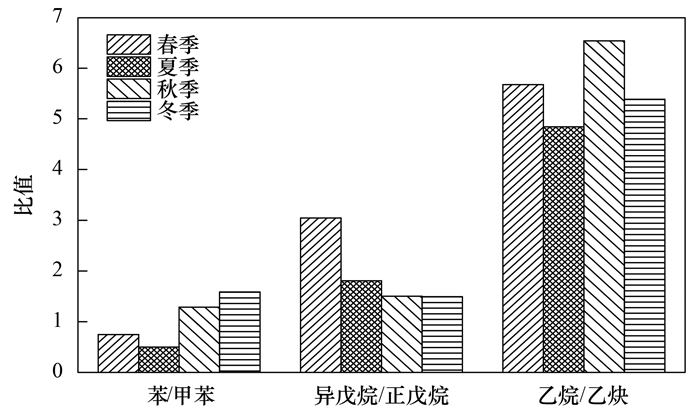
|
图 3 VOCs典型示踪物特征比值 Fig. 3 Characteristic ratio of VOCs indicating pollution sources |
VOCs在大气中参与二次化学反应具有明显的季节性特征, 春夏季以光化学反应生成O3为主, 秋冬季主要转化为PM2.5中的二次有机气溶胶(SOA), 因此分别对春夏季VOCs的臭氧生成潜势(OFP)和秋冬季的SOA生成潜势进行研究.
2.2.1 臭氧生成潜势2019年春夏季天津市烷烃、烯烃、芳香烃和炔烃的臭氧生成潜势分别为21.0、60.2、41.5和1.2 μg·m-3, 占总OFP的比例分别为16.9%、48.6%、33.5%和1.0%.图 4显示了春夏季浓度较高的25种VOCs浓度贡献率及其臭氧生成潜势贡献率.其中, 乙烯(15.4%)、丙烯(10.8%)、间/对-二甲苯(10.1%)、1, 2, 3-三甲苯(7.3%)、甲苯(6.4%)、异戊二烯(6.0%)、反-2-丁烯(4.7%)、顺-2-戊烯(4.2%)、邻-二甲苯(2.8%)和间-乙基甲苯(2.7%)是臭氧生成潜势贡献较高的10种化合物, 占总OFP的56.9%.乙烷和丙烷虽然对VOCs浓度贡献高达17.6%和15.2%, 但其OFP贡献仅为2.7%和1.3%, 烯烃和芳香烃是对天津市春夏季臭氧生成贡献较高的两类化合物.烷烃虽然在环境空气中浓度较高, 但由于其相对稳定, 反应活性低, 对臭氧生成贡献较小; 烯烃类化合物由于C=C双键的存在使其光化学反应活性较高, 对臭氧的贡献明显高于芳香烃和烷烃.因此, 优先控制臭氧生成潜势较高的烯烃和芳香烃类化合物排放是改善天津市春夏季臭氧污染的关键.
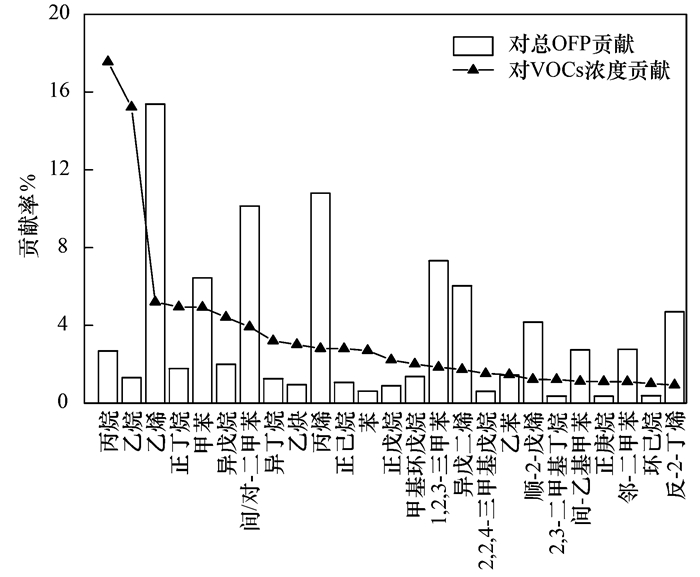
|
图 4 春夏季主要VOCs物种浓度贡献及臭氧生成潜势贡献 Fig. 4 Contributions of concentration and OFP of major VOCs species during spring and summer |
本研究测定的56种VOCs中, 对SOA生成潜势有贡献的主要包括13种非芳香烃类物质及15种芳香烃类化合物(表 2).根据气溶胶生成系数(FAC)估算结果, 2019年秋冬季天津市烷烃和芳香烃的SOA生成潜势分别为0.04 μg·m-3和0.52 μg·m-3, 占总VOCs的SOA生成潜势比例分别为7.8%和91.5%.虽然FAC估算的SOA生成潜势偏低, 但是仍能给出SOA生成的大致数量级, 并指明各SOA前体物的相对贡献[47].芳香烃类化合物是天津市秋冬季SOA生成潜势的主要贡献者, 贡献率较高的物种主要为邻-二甲苯(17.0%)、甲苯(15.7%)、间/对-二甲苯(14.7%)、乙苯(12.5%)、邻-乙基甲苯(9.8%)和苯(8.6%), 对SOA生成潜势累计贡献达78.3%, 为秋冬季重点控制VOCs物种.
|
|
表 2 秋冬季VOCs物种SOA生成潜势1) Table 2 Formation potential of VOCs to SOA during autumn and winter |
2.3 污染来源分析
利用PMF受体模型对2019年春夏季和秋冬季大气VOCs进行来源解析, 综合考虑VOCs物种的浓度水平、示踪作用以及实际污染源排放情况, 选择样本缺失少、浓度水平高且示踪意义明确的物种进行模型计算(春夏季选择25种, 秋冬季选择27种, 图 5).多次运行分析使Q值收敛且趋向最小, 春夏季和秋冬季均选取7个因子时计算结果较为稳定, Q(true)/Q(robust)值分别为1.05和1.08, 多数物种观测值与模拟值的拟合相关性R2>0.90, 能够较好地解释原始数据所包含的源信息.春夏季解析结果中, 因子1以C2~C5低碳烷烃贡献率较高且含有少量苯系物, 低碳类烷烃化合物是机动车尾气排放的主要组分[48], 芳香烃类组分比例较高也是我国油品的主要特点[49], 故判定因子1为机动车排放源.因子2中邻-二甲苯、间/对-二甲苯、甲苯、乙苯以及戊烷、己烷类有机溶剂成分载荷较高, 判定为溶剂使用源.因子3的乙炔占比较高, 由于乙炔是燃烧源的重要示踪物[50], 故认为因子3代表燃烧源.因子4乙烯和丙烯贡献较大, 二者是石油化工行业的重要基础化工原料和产品, 故判定因子4为石化工业排放源.因子5丁烷、戊烷和乙烷、丙烷贡献较高, 其中丁烷是液化石油气(LPG)的主要成分[43, 51], 戊烷是汽油挥发的重要示踪物[52], 乙烷、丙烷是天然气(NG)的组成成分, 因此认为因子5代表LPG/NG和汽油挥发源.因子6中异戊二烯贡献率高达90.2%, 异戊二烯是天然源排放的标识物种[53], 因子6判定为天然源.因子7中载荷较高的为顺-2-戊烯、正丁烯和苯, 可能受其他工艺过程和来源影响.秋冬季解析结果与春夏季总体类似, 但未解析到明显天然源影响, 同时LPG/汽油挥发源和NG被识别为2个因子.
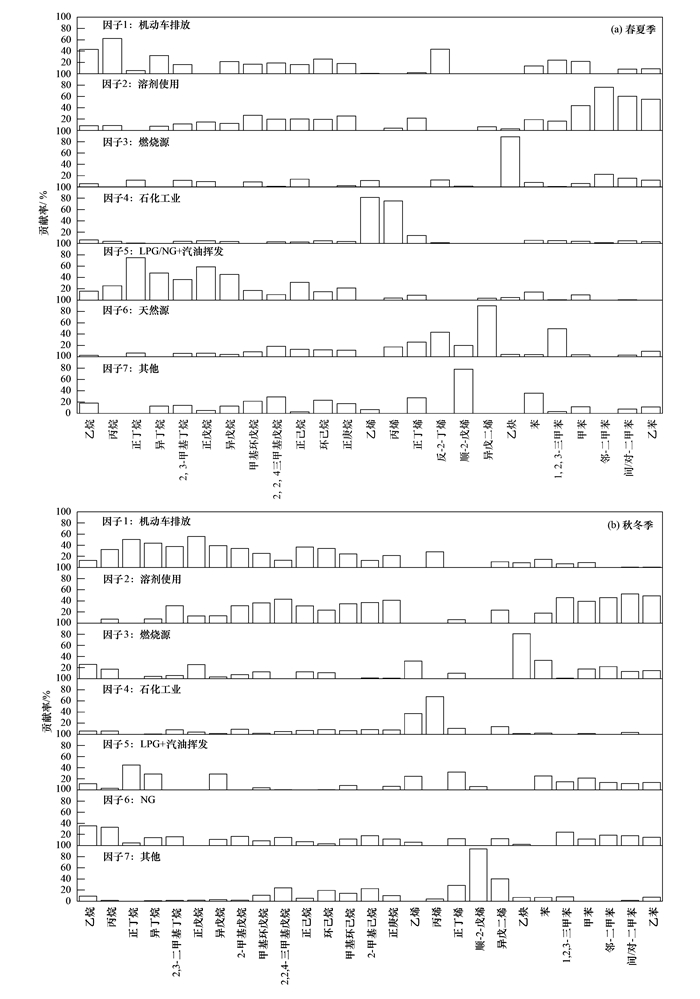
|
图 5 2019年春夏季和秋冬季VOCs来源成分谱图 Fig. 5 Source profiles of VOCs for spring-summer and autumn-winter in 2019 |
解析结果表明(图 6), 2019年天津市春夏季大气VOCs来源主要包括:机动车排放源、LPG/NG和汽油挥发源、溶剂使用源、石化工业排放源、燃烧源和天然源, 对VOCs浓度贡献率分别为: 29.2%、19.9%、16.4%、10.3%、7.3%和6.6%.秋冬季主要来源为: LPG/NG和汽油挥发源、机动车排放源、燃烧源、溶剂使用源和石化工业排放源, 贡献率分别为: 32.4%、21.9%、18.5%、13.3%和8.4%.与春夏季解析结果相比, 秋冬季LPG/NG以及燃烧源影响明显增加, 贡献率分别上升62.8%和153.4%;未解析到明显天然源影响, 其他源贡献下降18.4%~25.0%.结合解析得到的各源类成分谱结果, 春夏季石化工业源和溶剂使用源排放分别以烯烃类和芳香烃类化合物为主, 臭氧生成潜势较高, 是春夏季重点管控对象; 秋冬季燃烧源和溶剂使用源排放的芳香烃类物种占比较高, 是SOA生成的重要前体物, 为重点管控源类.
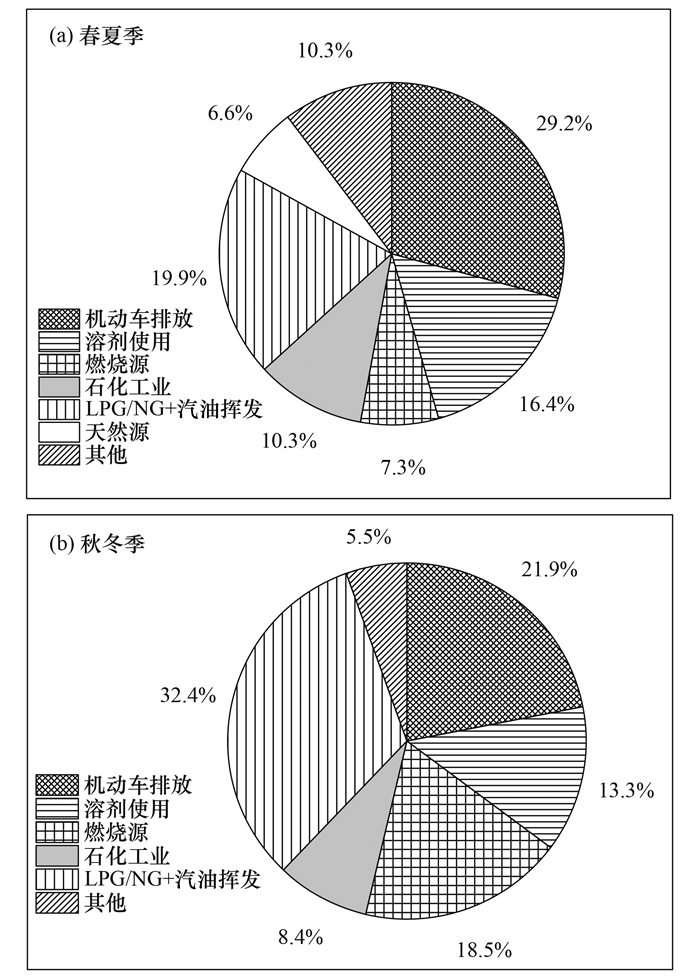
|
图 6 2019年春夏季和秋冬季主要污染源对VOCs贡献 Fig. 6 Source contributions of atmospheric VOCs for spring-summer and autumn-winter in 2019 |
(1) 2019年天津市VOCs年均浓度为48.9 μg·m-3, 烷烃、芳香烃、烯烃和炔烃占比分别为65.0%、17.4%、14.6%和3.0%.季节变化总体呈现冬季浓度最高、春季最低的污染特征, 化学组成上烷烃、芳香烃和炔烃占比分别在秋季、夏季和冬季最高, 烯烃占比在夏季和冬季均较高.
(2) 春夏季烷烃、烯烃、芳香烃和炔烃的臭氧生成潜势贡献分别为16.9%、48.6%、33.5%和1.0%, 烯烃和芳香烃贡献较高.乙烯、丙烯、间/对-二甲苯、1, 2, 3-三甲苯、甲苯、异戊二烯、反-2-丁烯、顺-2-戊烯、邻-二甲苯和间-乙基甲苯的臭氧生成潜势较高, 是春夏季臭氧污染防控的关键物种.
(3) 芳香烃是秋冬季SOA生成潜势的重要贡献者, 贡献率高达91.5%.邻-二甲苯、甲苯、间/对-二甲苯、乙苯、邻-乙基甲苯和苯是SOA生成潜势的主要贡献物种, 为秋冬季重点控制VOCs物种.
(4) 天津市春夏季大气VOCs来源主要为:机动车排放源、LPG/NG和汽油挥发源、溶剂使用源、石化工业源、燃烧源和天然源, 贡献率分别为: 29.2%、19.9%、16.4%、10.3%、7.3%和6.6%;秋冬季来源主要为: LPG/NG和汽油挥发源、机动车排放源、燃烧源、溶剂使用源和石化工业源, 贡献率分别为: 32.4%、21.9%、18.5%、13.3%和8.4%.
(5) 各源类成分谱解析结果表明, 石化工业源和溶剂使用源排放为天津市春夏季臭氧防控的重点管控对象, 燃烧源和溶剂使用源排放为秋冬季SOA防控的重点源类.
| [1] | Wang T, Xue L K, Brimblecombe P, et al. Ozone pollution in China: a review of concentrations, meteorological influences, chemical precursors, and effects[J]. Science of the Total Environment, 2017, 575: 1582-1596. |
| [2] | Zhang Y L, Wang X M, Zhang Z, et al. Sources of C2-C4 alkenes, the most important ozone nonmethane hydrocarbon precursors in the Pearl River Delta region[J]. Science of the Total Environment, 2015, 502: 236-245. |
| [3] |
邹宇, 邓雪娇, 王伯光, 等. 广州番禺大气成分站挥发性有机物的污染特征[J]. 中国环境科学, 2013, 33(5): 808-813. Zou Y, Deng X J, Wang B G, et al. Pollution characteristics of volatile organic compounds in Panyu Composition Station[J]. China Environmental Science, 2013, 33(5): 808-813. |
| [4] |
邹宇, 邓雪娇, 李菲, 等. 广州番禺大气成分站复合污染过程VOCs对O3与SOA的生成潜势[J]. 环境科学, 2017, 38(6): 2246-2255. Zou Y, Deng X J, Li F, et al. Effect of VOCs on O3 and SOA formation potential during the combined pollution process in Guangzhou Panyu atmospheric composition station[J]. Environmental Science, 2017, 38(6): 2246-2255. |
| [5] |
马永亮, 谭吉华, 贺克斌, 等. 佛山灰霾期挥发性有机物的污染特征[J]. 环境科学, 2011, 32(12): 3549-3554. Ma Y L, Tan J H, He K B, et al. Characteristics of volatile organic compounds during haze episode in Foshan city[J]. Environmental Science, 2011, 32(12): 3549-3554. |
| [6] |
王伯光, 张远航, 邵敏. 珠江三角洲大气环境VOCs的时空分布特征[J]. 环境科学, 2004, 25(S1): 7-15. Wang B G, Zhang Y H, Shao M. Special and temporal distribution character of VOCs in the ambient air of Peal River Delta region[J]. Environmental Science, 2004, 25(S1): 7-15. |
| [7] | Huang C, Chen C H, Li L, et al. The study of emission inventory on anthropogenic air pollutants and VOC species in the Yangtze River Delta region, China[J]. Atmospheric Chemistry and Physics Discussions, 2011, 11(1): 951-983. |
| [8] |
王红丽. 上海市光化学污染期间挥发性有机物的组成特征及其对臭氧生成的影响研究[J]. 环境科学学报, 2015, 35(6): 1603-1611. Wang H L. Characterization of Volatile Organic Compounds (VOCs) and the impact on ozone formation during the photochemical smog episode in Shanghai, China[J]. Acta Scientiae Circumstantiae, 2015, 35(6): 1603-1611. |
| [9] |
王倩. 2019年5月上海复合污染过程中挥发性有机物的污染特征及来源[J]. 环境科学, 2020, 41(6): 2555-2564. Wang Q. Chemical characteristics and sources of volatile organic compounds in Shanghai during an ozone and particulate pollution episode in May 2019[J]. Environmental Science, 2020, 41(6): 2555-2564. |
| [10] | 叶露. 上海北郊大气挥发性有机物(VOCs)变化特征及来源解析[J]. 装备环境工程, 2020, 17(6): 107-116. |
| [11] |
林旭, 陈超, 叶辉, 等. 杭州秋季大气VOCs变化特征及化学反应活性研究[J]. 中国环境监测, 2020, 36(2): 196-204. Lin X, Chen C, Ye H, et al. Variation characteristics and chemical reactivity of VOCs in different functional zones of Hangzhou in autumn[J]. Environmental Monitoring in China, 2020, 36(2): 196-204. |
| [12] |
乔月珍, 陈凤, 赵秋月, 等. 2015年南京市城区挥发性有机物组成特征及大气反应活性[J]. 环境科学, 2019, 40(5): 2062-2068. Qiao Y Z, Chen F, Zhao Q Y, et al. Composition and atmospheric reactivity of ambient Volatile Organic Compounds (VOCs) in the urban area of Nanjing, China[J]. Environmental Science, 2019, 40(5): 2062-2068. |
| [13] | Song M D, Tan Q W, Feng M, et al. Source apportionment and secondary transformation of atmospheric nonmethane hydrocarbons in Chengdu, southwest China[J]. Journal of Geophysical Research: Atmospheres, 2018, 123(17): 9741-9763. |
| [14] |
徐晨曦, 陈军辉, 韩丽, 等. 成都市2017年夏季大气VOCs污染特征、臭氧生成潜势及来源分析[J]. 环境科学研究, 2019, 32(4): 619-626. Xu C X, Chen J H, Han L, et al. Analyses of pollution characteristics, ozone formation potential and sources of VOCs atmosphere in Chengdu city in summer 2017[J]. Research of Environmental Sciences, 2019, 32(4): 619-626. |
| [15] |
印红玲, 袁桦蔚, 叶芝祥, 等. 成都市大气中挥发性有机物的时空分布特征及臭氧生成潜势研究[J]. 环境科学学报, 2015, 35(2): 386-393. Yin H L, Yuan H W, Ye Z X, et al. Temporal and spatial distribution of VOCs and their OFP in the atmosphere of Chengdu[J]. Acta Scientiae Circumstantiae, 2015, 35(2): 386-393. |
| [16] |
刘奇琛, 黄婧, 郭新彪. 北京市大气挥发性有机物(VOCs)的污染特征及来源[J]. 生态毒理学报, 2017, 12(3): 49-61. Liu Q C, Huang J, Guo X B. Pollution characteristics and sources of ambient Volatile Organic Compounds (VOCs) in Beijing[J]. Asian Journal of Ecotoxicology, 2017, 12(3): 49-61. |
| [17] |
孙杰, 王跃思, 吴方堃, 等. 唐山市和北京市夏秋季节大气VOCs组成及浓度变化[J]. 环境科学, 2010, 31(7): 1438-1443. Sun J, Wang Y S, Wu F K, et al. Concentration and change of VOCs in summer and autumn in Tangshan[J]. Environmental Science, 2010, 31(7): 1438-1443. |
| [18] |
丁洁然, 景长勇. 唐山夏季大气VOCs污染特征及臭氧生成潜势[J]. 环境工程, 2016, 34(6): 130-135. Ding J R, Jing C Y. Pollution characteristics and ozone formation potential of ambient VOCs in summer in Tangshan[J]. Environmental Engineering, 2016, 34(6): 130-135. |
| [19] |
王雨, 王丽涛, 杨光, 等. 邯郸市秋季大气挥发性有机物污染特征[J]. 环境科学研究, 2019, 32(7): 1134-1142. Wang Y, Wang L T, Yang G, et al. Characteristics of volatile organic compounds in autumn in Handan city, China[J]. Research of Environmental Sciences, 2019, 32(7): 1134-1142. |
| [20] | 中国环境监测总站. 2018-2019年全国城市空气质量报告[EB/OL]. http://www.cnemc.cn/jcbg/kqzlzkbg, 2019-12-17. |
| [21] |
高璟赟, 唐邈, 陈魁, 等. 天津市不同功能区大气挥发性有机物污染特征及来源分析[J]. 环境污染与防治, 2016, 38(5): 43-47. Gao J Y, Tang M, Chen K, et al. Pollution characteristics and source analysis of atmospheric volatile organic compounds in different function areas, Tianjin[J]. Environmental Pollution and Control, 2016, 38(5): 43-47. |
| [22] |
董海燕, 朱玲, 边玮瓅, 等. 天津市滨海新区夏季挥发性有机物的污染特征分析[J]. 环境污染与防治, 2016, 38(5): 77-81. Dong H Y, Zhu L, Bian W L, et al. Pollution characteristics of volatile organic compounds in the summer of Binhai New Area, Tianjin[J]. Environmental Pollution and Control, 2016, 38(5): 77-81. |
| [23] |
翟增秀, 邹克华, 李伟芳, 等. 天津中心城区环境空气挥发性有机物污染特征分析[J]. 环境科学, 2013, 34(12): 4513-4518. Zhai Z X, Zou K H, Li W F, et al. Pollution characterization of volatile organic compounds in ambient air of Tianjin downtown[J]. Environmental Science, 2013, 34(12): 4513-4518. |
| [24] |
张新民, 柴发合, 岳婷婷, 等. 天津武清大气挥发性有机物光化学污染特征及来源[J]. 环境科学研究, 2012, 25(10): 1085-1091. Zhang X M, Chai F H, Yue T T, et al. Photochemical characteristics and sources of volatile organic compounds in Wuqing, Tianjin[J]. Research of Environmental Sciences, 2012, 25(10): 1085-1091. |
| [25] |
韩萌, 卢学强, 冉靓, 等. 天津市城区夏季VOCs来源解析[J]. 环境科学与技术, 2011, 34(10): 76-80. Han M, Lu X Q, Ran L, et al. Source apportionment of volatile organic compounds in Urban Tianjin in the summer[J]. Environmental Science & Technology, 2011, 34(10): 76-80. |
| [26] | Wang J D, Zhao B, Wang S X, et al. Particulate matter pollution over China and the effects of control policies[J]. Science of the Total Environment, 2017, 584-585: 426-447. |
| [27] | Zheng B, Tong D, Li M, et al. Trends in China's anthropogenic emissions since 2010 as the consequence of clean air actions[J]. Atmospheric Chemistry and Physics, 2018, 18(19): 14095-14111. |
| [28] |
王文兴, 柴发合, 任阵海, 等. 新中国成立70年来我国大气污染防治历程、成就与经验[J]. 环境科学研究, 2019, 32(10): 1621-1635. Wang W X, Chai F H, Ren Z H, et al. Process, achievements and experience of air pollution control in China since the founding of the People's Republic of China 70 years ago[J]. Research of Environmental Sciences, 2019, 32(10): 1621-1635. |
| [29] | Zeinali M, McConnell L L, Hapeman C J, et al. Volatile organic compounds in pesticide formulations: Methods to estimate ozone formation potential[J]. Atmospheric Environment, 2011, 45(14): 2404-2412. |
| [30] | Carter W P L. Development of ozone reactivity scales for volatile organic compounds[J]. Air & Waste, 1994, 44(7): 881-899. |
| [31] | Grosjean D, Seinfeld J H. Parameterization of the formation potential of secondary organic aerosols[J]. Atmospheric Environment (1967), 1989, 23(8): 1733-1747. |
| [32] | Grosjean D. In situ organic aerosol formation during a smog episode: Estimated production and chemical functionality[J]. Atmospheric Environment. Part A. General Topics, 1992, 26(6): 953-963. |
| [33] | Norris G, Duvall R, Brown S, et al. EPA positive matrix factorization (PMF) 5.0 fundamentals and user guide[R]. Washington, DC: U.S. Environmental Protection Agency, 2014. |
| [34] |
蒋美青, 陆克定, 苏榕, 等. 我国典型城市群O3污染成因和关键VOCs活性解析[J]. 科学通报, 2018, 63(12): 1130-1141. Jiang M Q, Lu K D, Su R, et al. Ozone formation and key VOCs in typical Chinese city clusters[J]. Chinese Science Bulletin, 2018, 63(12): 1130-1141. |
| [35] |
徐慧, 张晗, 邢振雨, 等. 厦门冬春季大气VOCs的污染特征及臭氧生成潜势[J]. 环境科学, 2015, 36(1): 11-17. Xu H, Zhang H, Xing Z Y, et al. Pollution characteristics and ozone formation potential of ambient VOCs in winter and spring in Xiamen[J]. Environmental Science, 2015, 36(1): 11-17. |
| [36] |
黄海梅, 戴春皓, 王章玮, 等. 长沙市大气挥发性有机物的组成与来源[J]. 环境化学, 2019, 38(3): 539-547. Huang H M, Dai C H, Wang Z W, et al. Composition and source apportionment of ambient volatile organic compounds in Changsha, China[J]. Environmental Chemistry, 2019, 38(3): 539-547. |
| [37] |
刘泽常, 张帆, 侯鲁健, 等. 济南市夏季环境空气VOCs污染特征研究[J]. 环境科学, 2012, 33(10): 3656-3661. Liu Z C, Zhang F, Hou L J, et al. Pollution characteristics of VOCs in ambient air of Ji'nan City in summer[J]. Environmental Science, 2012, 33(10): 3656-3661. |
| [38] |
司雷霆, 王浩, 李洋, 等. 太原市夏季大气VOCs污染特征及臭氧生成潜势[J]. 中国环境科学, 2019, 39(9): 3655-3662. Si L T, Wang H, Li Y, et al. Pollution characteristics and ozone formation potential of ambient VOCs in summer in Taiyuan[J]. China Environmental Science, 2019, 39(9): 3655-3662. |
| [39] |
牛月圆, 刘倬诚, 李如梅, 等. 阳泉市区夏季挥发性有机物污染特征、来源解析及其环境影响[J]. 环境科学, 2020, 41(7): 3066-3075. Niu Y Y, Liu Z C, Li R M, et al. Characteristics, source apportionment, and environmental impact of volatile organic compounds in summer in Yangquan[J]. Environmental Science, 2020, 41(7): 3066-3075. |
| [40] | Gee I L, Sollars C J. Ambient air levels of volatile organic compounds in Latin American and Asian cities[J]. Chemosphere, 1998, 36(11): 2497-2506. |
| [41] | Perry R, Gee I L. Vehicle emissions in relation to fuel composition[J]. Science of the Total Environment, 1995, 169(1-3): 149-156. |
| [42] | dos Santos C Y M, de Almeida Azevedo D, de Aquino Neto F R. Atmospheric distribution of organic compounds from urban areas near a coal-fired power station[J]. Atmospheric Environment, 2004, 38(9): 1247-1257. |
| [43] | Barletta B, Meinardi S, Rowland F S, et al. Volatile organic compounds in 43 Chinese cities[J]. Atmospheric Environment, 2005, 39(32): 5979-5990. |
| [44] |
黄俊梅, 赵波. 上海市吴泾工业区VOCs的监测分析与来源解析[J]. 环境科学与技术, 2014, 37(S2): 382-386. Huang J M, Zhao B. Monitoring analysis and source apportionment of volatile organic compounds in Shanghai Wujing Industrial Zone[J]. Environmental Science & Technology, 2014, 37(S2): 382-386. |
| [45] | Liu Y, Shao M, Fu L L, et al. Source profiles of Volatile Organic Compounds (VOCs) measured in China: part Ⅰ[J]. Atmospheric Environment, 2008, 42(25): 6247-6260. |
| [46] |
盛涛, 陈筱佳, 高松, 等. VOCs比值法的应用研究进展[J]. 环境科学与技术, 2018, 41(12): 122-130. Sheng T, Chen X J, Gao S, et al. Progress in the research of application of VOCs ratio method[J]. Environmental Science & Technology, 2018, 41(12): 122-130. |
| [47] |
吕子峰, 郝吉明, 段菁春, 等. 北京市夏季二次有机气溶胶生成潜势的估算[J]. 环境科学, 2009, 30(4): 969-975. Lv Z F, Hao J M, Duan J C, et al. Estimate of the formation potential of secondary organic aerosol in Beijing summertime[J]. Environmental Science, 2009, 30(4): 969-975. |
| [48] |
杨帆, 闫雨龙, 戈云飞, 等. 晋城市冬季环境空气中挥发性有机物的污染特征及来源解析[J]. 环境科学, 2018, 39(9): 4042-4050. Yang F, Yan Y L, Ge Y F, et al. Characteristics and source apportionment of ambient volatile organic compounds in winter in Jincheng[J]. Environmental Science, 2018, 39(9): 4042-4050. |
| [49] | Jorquera H, Rappenglück B. Receptor modeling of ambient VOC at Santiago, Chile[J]. Atmospheric Environment, 2004, 38(25): 4243-4263. |
| [50] |
邹巧莉, 孙鑫, 田旭东, 等. 嘉善夏季典型时段大气VOCs的臭氧生成潜势及来源解析[J]. 中国环境监测, 2017, 33(4): 91-98. Zou Q L, Sun X, Tian X D, et al. Ozone formation potential and sources apportionment of atmospheric VOCs during typical periods in summer of Jiashan[J]. Environmental Monitoring in China, 2017, 33(4): 91-98. |
| [51] |
张玉欣, 安俊琳, 王俊秀, 等. 南京工业区挥发性有机物来源解析及其对臭氧贡献评估[J]. 环境科学, 2018, 39(2): 502-510. Zhang Y X, An J L, Wang J X, et al. Source analysis of volatile organic compounds in the Nanjing industrial area and evaluation of their contribution to ozone[J]. Environmental Science, 2018, 39(2): 502-510. |
| [52] | Tsai W Y, Chan L Y, Blake D R, et al. Vehicular fuel composition and atmospheric emissions in South China: Hong Kong, Macau, Guangzhou, and Zhuhai[J]. Atmospheric Chemistry and Physics, 2006, 6(11): 3281-3288. |
| [53] | An J L, Zhu B, Wang H L, et al. Characteristics and source apportionment of VOCs measured in an industrial area of Nanjing, Yangtze River Delta, China[J]. Atmospheric Environment, 2014, 97: 206-214. |
 2021, Vol. 42
2021, Vol. 42


